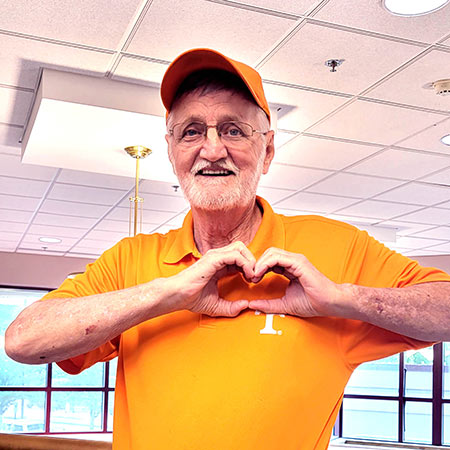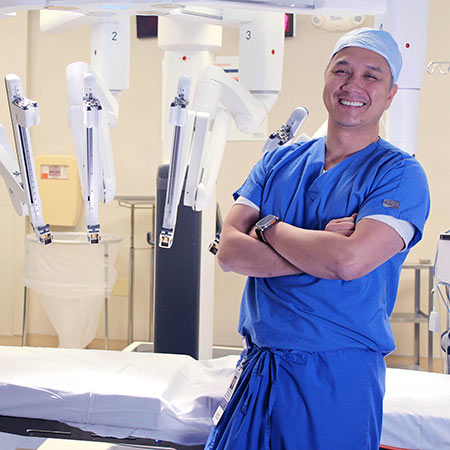
When James “Jimmy” Howard went to his physician regarding an issue with a blocked artery, he didn’t realize the outcome of that visit would reveal another potentially serious disease: possible lung cancer. Howard also did not realize one of the treatments used to address his suspected cancer was also a first for Parkridge Medical Center and Chattanooga: a robotic-assisted lobectomy, or the removal of part of his lung by the surgeon using a state-of-the-art surgical robot.
Howard, 69, underwent a vascular procedure in December for a partially blocked artery. While in recovery from that procedure, he experienced numbness in his right leg. When he returned to his vascular provider to provide the update and additional tests were done, it was discovered Howard’s leg wasn’t getting adequate blood flow, which caused his numbness. His provider then arranged for Howard to go to the Parkridge Medical Center ER to prepare for immediate surgery to repair the blockage. It was there that life threw Howard, a former collegiate baseball player and lifelong fan, a serious curve ball.
“Aside from my leg numbness, while I was in the ER, I had a cardiac event,” Howard said. “From the tests that came following my cardiac event, it was discovered I needed triple-bypass surgery. Those tests also showed I had a spot on my right lung. So, I’m in the hospital with a numb leg, looking at undergoing triple-bypass heart surgery and, now, possible lung cancer.”
The spot in Howard’s lung was located and biopsied using Parkridge’s new state-of-the-art robot to assist in performing lung bronchoscopies. In the lung bronchoscopy, Parkridge pulmonologist Minerva Covarrubias, MD, using the robot, entered Howard’s lung through his trachea and was able to very quickly locate and biopsy the spot without any incisions or additional invasive procedures. The technology uses prior CT imaging scans to literally map the patient’s lung before the procedure. Dr. Covarrubias, with the aid of the robot, then guides the very small, thin endoscope to the nodule location with high precision and clarity. Once located, a specimen may be taken directly from the nodule for biopsy and needed follow-up. In Howard’s case, the nodule was diagnosed with the conclusion it would be best to completely remove the nodule.

Following Howard’s bronchoscopy, he did additional research around the thoracic surgery capabilities of Parkridge’s cardiovascular and thoracic surgeons and discovered he may have an option to address his lung through yet a different robotic procedure.
A Centennial Cardiovascular and Thoracic Surgery at Parkridge surgeon since April, double-board-certified cardiovascular and thoracic surgeon, Dr. Bao-Thuy Hoang, MD, has received extensive training and experience in robotic surgery in his more than 15 years’ experience in complex surgeries of the heart and lungs. Different from “traditional” surgery, robotic surgery typically has smaller patient incisions with less blood loss, a shorter hospital stay, quicker recovery and, most importantly, a better cancer and lymph node resection. The robot is a system of highly dexterous “arms” that wield and manipulate surgical instruments with extreme precision - far more precisely than the human hand could accomplish - with all movements personally directed by the hands and skills of the surgeon.
Following a few weeks of recovery from his successful heart surgery, Howard felt it was now time to address the spot on his lung and assessed his options.
Dr. Hoang robotically performed the right upper lobectomy, or the removal of a portion of Howard’s lung that contained the spot, on May 10. It was the first time a robotic-assisted surgery of this type had been performed at Parkridge Medical Center, and Dr. Hoang is currently the only thoracic surgeon in the Chattanooga region who performs the procedure.
“Before robotic surgery, most surgeons would hesitate to perform a major lung operation after what Mr. Howard has been through,” Dr. Hoang said. “But with this new and proven technology, we can do the operation better and help our patient recover faster with minimal risks. Mr. Howard is a prime example what is possible today at Parkridge.”
The surgery was successful, and Howard is now following up with other specialists for post-op care. He said he is feeling better and slowly getting his strength back. A recent pathology report showed no sign of cancer in Howard following his surgery, and he plans to follow his course of treatment as prescribed.
For now, though, Howard plans to take it easy and is home recovering with the support of his family and medical providers.
“I received great care from all the providers at Centennial Heart at Parkridge, Centennial Cardiovascular and Thoracic Surgery at Parkridge and Parkridge Medical Center,” Howard said. “I’m in good spirits and ready to get back on the golf course.”
$webqFacilityNumber
Need a Physician?